Kashyap Kompella, CEO of the global technology industry analyst firm RPA2AI Research notes, Powerful applications in a wide variety of areas from image and speech recognition, and video processing.

Artificial-intelligence-analytics-data-sciences.
Photo: BL on Campus
AI is certainly a hot area today, but it is by no means a new field. In fact, the term Artificial Intelligence was coined nearly 65 years ago in 1956. For nearly two decades after that, there was a wave of great hope around intelligent computers and the hard problems they’d be able to solve. But the first AI wave was followed by many years of disappointment because of the limitations of AI, and the funding for AI projects dried up. Later, a second wave of an AI boomed in the early 1980s, and again followed by an “AI winter” till the early 1990s.
The field of AI has been making steady progress during all these years but it’s the public perception of AI that kept alternating between hype and realism. In the present era, particularly in the last eight to ten years, we have seen the return of a bigger AI wave. To be sure, hype abounds but the potential applications of AI are more widespread, and even if the interest in AI cools a bit, there are still a reasonable number of applications to be developed just with currently existing AI capabilities. So, what has fuelled the rise of AI now? It’s deep learning, which represents a step-jump from the previous generations of AI.
But what exactly is deep learning?
Deep Learning is the popular name for a branch of machine learning techniques called Artificial Neural Networks (neural nets). Neural nets are said to be inspired by how the human brain works. A neural network is a data processing mechanism, arranged as a series of layers of artificial “neurons” that are connected to other neurons in the setup. The connections between the neurons are called edges...
With the basics of Artificial Intelligence, Machine Learning and Deep Learning out of the way, we’ll start exploring the different use cases starting with the next column of Future Tense.
Source: BL on Campus










